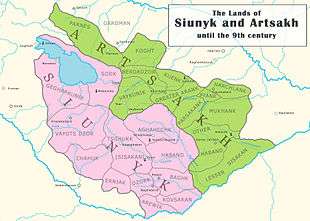Syunik (historic province)
| Սյունիք | |||||
| Province of Kingdom of Armenia | |||||
| |||||
| Capital | Baghaberd | ||||
| Historical era | Antiquity, Middle Ages | ||||
| • | Established | 189 BC | |||
| • | Province of Armenia | 189 BC - 428 | |||
| • | Disestablished | 428 | |||
Syunik (Armenian: Սյունիք) was the ninth province (nahang) of the Kingdom of Armenia from 189 BC until 428 AD. From the 7th to 9th centuries, it fell under Arab control.[1] In 821, it formed the Armenian principality of Khachen and around the year 1000 was proclaimed the Kingdom of Artsakh, which was one of the last medieval eastern Armenian kingdoms and principalities to maintain its autonomy following the Turkic invasions of the 11th to 14th centuries.[2]
History

Inscriptions found in the region around Lake Sevan attributed to King Artaxias I confirm that in the 2nd century BC the District of Syunik constituted part of the Ancient Armenia.[3][4][5]
Early rulers
The first dynasty to rule Syunik was the Siunia Dynasty, beginning in the 1st century. The first known Naxarar ruler was Valinak Siak (c. 330) and his successor was his brother Andok or Andovk (Antiochus, c. 340). In 379 Babik (Bagben) the son of Andok, was re-established as a Naxarar by the Mamikonian family. Babik had a sister called Pharantzem who had married the Arsacid Prince Gnel, nephew of the Armenian King Arsaces II (Arshak II) and later married Arsaces II as her second husband. Babik’s rule lasted for less than ten years and by about 386 or 387, Dara was deposed by the Sassanid Empire.
Valinak (c. 400-409) was followed by Vasak (409-452). Vasak had two sons: Babik (Bagben), Bakur and a daughter who married Vasak’s successor, Varazvahan (452-472). Varazvahan’s son Gelehon ruled from 470-477, who died in 483. Babik (Bagben) the brother of Varazvahan became the new Naxarar in 477. Hadz the brother of Gelehon died on September 25, 482. The Syunik Province was later governed by Vahan (c. 570), Philip (Philipo, c. 580), Stephen (Stephanos, c. 590-597), Sahak (Isaac, c. 597) and Grigor (Gregory, until 640).
See also
References
- ↑ Hewsen, Robert H (2001). Armenia: A Historical Atlas. Chicago: University of Chicago Press. p. 102. ISBN 0-226-33228-4.
- ↑ Hewsen. Armenia, pp. 118-121.
- ↑ Borisov ""nscriptions of Artaxia (Artashes), King of Armenia, 1946, No 2"
- ↑ Historical-Philological Magazine, 1965, No 4
- ↑ A.G. Perikhanyan, "Aramian Inscription from Zangezur"
Coordinates: 39°15′00″N 46°15′00″E / 39.2500°N 46.2500°E
